Saturday 19th June 2022
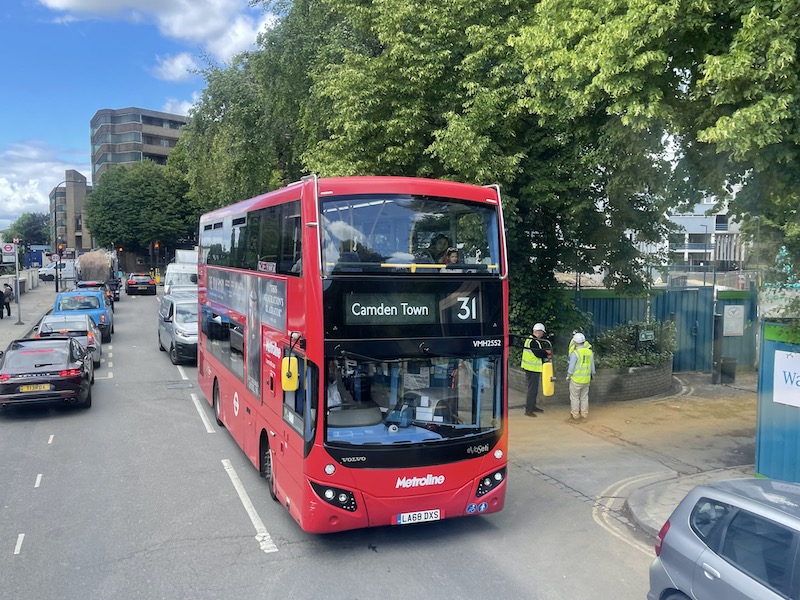
Next week isn’t going to be a good week for public transport. As well as strikes on the National Rail network on Tuesday, Thursday and Saturday with knock on impacts on other days there’s a strike on the London Underground on Tuesday continuing into Wednesday morning and by Friday TfL’s current funding runs out. Yet again there’ll no doubt be another eleventh hour and fifty ninth minute announcement about a six month extension but as I’ve said before, this is no way to be running a capital city’s public transport.
Meanwhile London’s bus passengers have nothing to look forward to; quite the reverse.
Over the last couple of weeks I’ve been out and about travelling all over central London taking a look at the likely impact of TfL’s proposed cuts to bus services, assessing which ones make sense and which don’t. Here’s my verdict which I’m dividing into two parts so it’s not too much of a hefty read. Part 2 will follow tomorrow.
Fortunately since my last blogpost on the bus changes when they were published at the beginning of the month, TfL have added 15 decent explanatory area maps to its consultation website showing exactly what’s proposed with each service withdrawal and rerouting area by area. I’ve used these to illustrate my thoughts on each proposal in the commentary which follows.
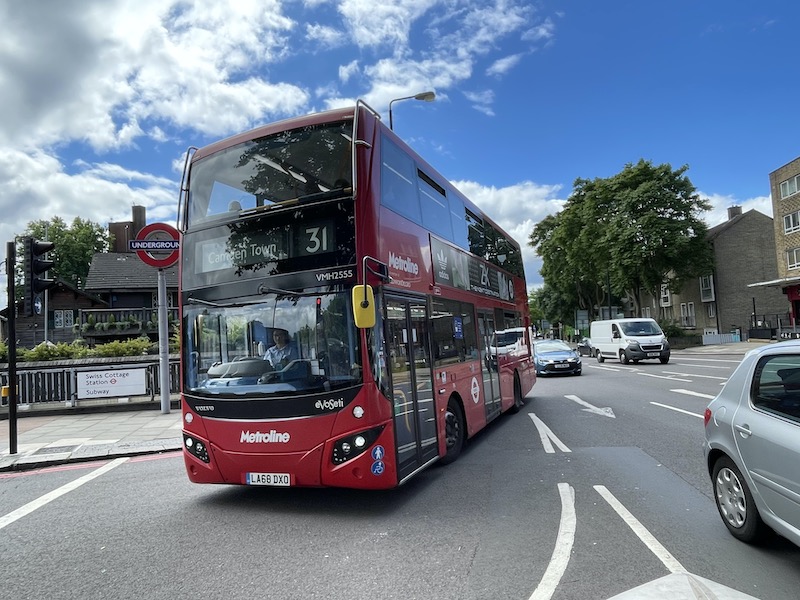
Let’s start with route 31 – one of the casualties of the cull with a complete withdrawal proposed; except of course it isn’t a withdrawal at all, as all the roads currently served will continue to see buses, but I reckon this is the most misguided proposal of the entire package. The ‘before’ and ‘after’ map below shows what’s planned for route 31’s replacement.

Basically the long established east-west route across Swiss Cottage (as in: route 31 has run this way since 1934) will be split into two halves at that point. And as if one split route isn’t enough, route 31 (pink) will instead be covered by splitting two other long established north-south routes at Swiss Cottage so that route 113 (orange) instead of continuing along Finchley Road to and from Baker Street and Oxford Street (which it’s done since 1939) and terminate at Marble Arch will head west to White City; and similarly route 189 (black) will head east to Camden Town instead of continuing along Abbey Road to and from Marble Arch.
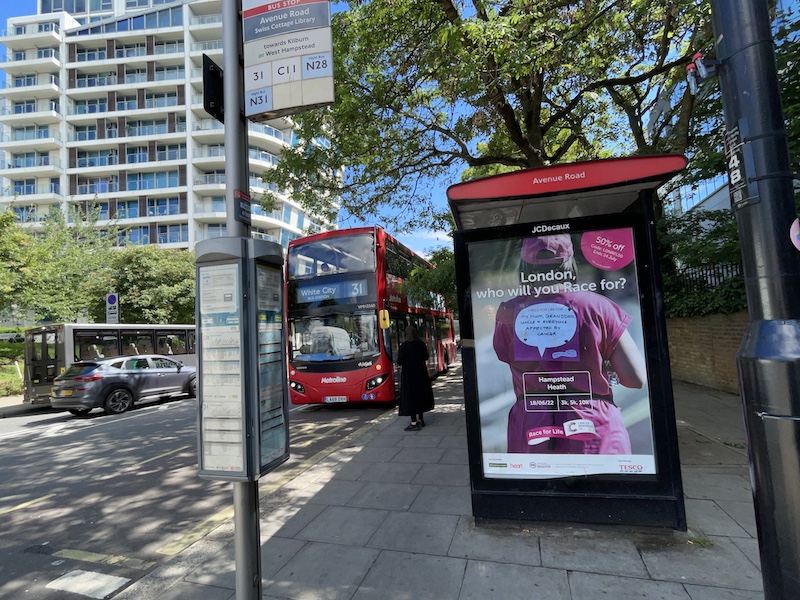
TfL reckon only 9% of passengers (1,620) on route 31 will be inconvenienced by having to change buses every day from the new look 113 to the new look 189 to continue their ‘cross Swiss Cottage’ journey.
I reckon that’s a disingenuous statistic as my rides and observations up and down this section of route showed at least half of passengers (and in some cases many more) on route 31 are making a journey across Swiss Cottage which will no longer be possible without a change. I’m not muddying the pool by adding in passengers making journeys on isolated sections further along the route, eg locally towards White City, since that’s an irrelevant statistic, but I guess TfL have included all passengers in their calculations to reach 9%.

Furthermore TfL reckon it’ll be convenient for passengers to hop off the new 113 and seamlessly jump on the new 189 (or vice versa) in Belsize Road – just to the west of Swiss Cottage which both routes will use. I can only conclude the bus route planners haven’t travelled along Belsize Road lately.

It’s not a pretty site. There’s barely enough room for one route, let alone two. It was chaotic when I was there.
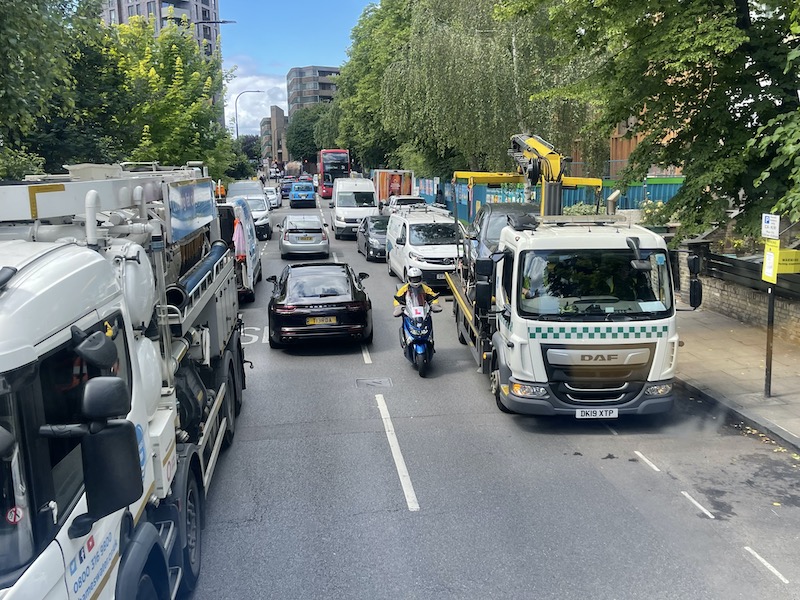
It’s also the case the vast majority of passengers on routes 113 and 189 also travel across Swiss Cottage on their current north-south route trajectories. Here TfL admit higher figures – 16% of passengers on the 113 and 19% on the 189 – will have to change. But remember those percentages include passengers, I assume, making local journeys in Edgware for example so don’t reflect numbers travelling at the affected point.

According to TfL this proposal is “to better match capacity to demand on the Finchley Road and Abbey Road corridors” so why disturb all those passengers using the long established route 31? It’ll just add to the misery and inconvenience they face and lead to further reductions in numbers travelling. If there’s too many buses on Abbey Road and Finchley Road, then reduce those frequencies; don’t mess with other long established routes like the 31.

I suggest terminating every other 113 at Swiss Cottage and reducing the frequency of route 189 from every 8 to every 10 minutes and terminate it at Baker Street station as one practical easy to implement option – buses can use the stand space vacated by the proposed withdrawal of route 74 ….

….. which by my travels on that route is probably a sensible proposal in that it’s largely replicated on its route to Putney by parallel route 414 from nearby Marble Arch as far as South Kensington and then route 430 (with a slight modification) from there to Putney. So that change makes sense. The change to route 31 patently doesn’t.
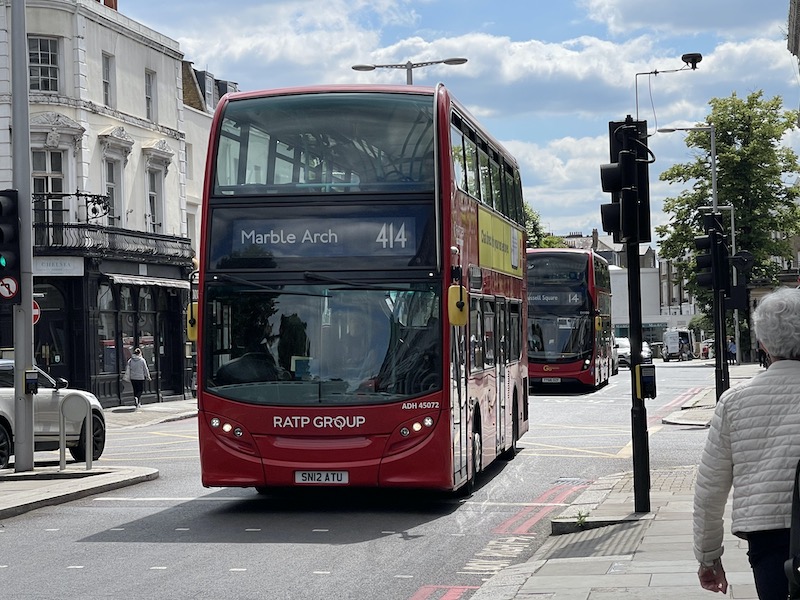
Here’s the map showing the replacement of route 74 (green) with current routes 414 (yellow) and 430 (red).

It also confirms the withdrawal of another long standing route – the 14 (Russell Square to Putney Heath) which will also be replaced by route 414 with a short extension to Putney Heath. If the latter is renumbered 14 it might not even get noticed. TfL are all about excess capacity in this area.

That’s why route 19 is rerouted via South Kensington instead of Sloane Square; route 49 is cut back from Clapham Junction to South Kensington and route 430 is diverted via Earls Court and Cromwell Road. And as a consequence it’s goodbye routes 14 and 74.
I can’t argue with the logic of reducing capacity in this area. My observations confirm there were far too many empty seats on offer. However, TfL’s figures show a sizeable number of daily trips – 4,331 (22%) – on route 49 will be broken and require a change of bus as a result of the change. That’s a worryingly high figure.

The above map also shows another sensible proposal – the complete withdrawal of route 72.

This route lost its mojo when it had to be truncated on the north side of Hammersmith Bridge following the bridge closure, after which it could no longer head south to Roehampton and instead became a rump of a route which can easily be replaced by the proposed extension of route 49 (pink) from White City to East Acton as well as existing route 272 (grey) to Hammersmith (together with a welcome increase in frequency from every 15 to every 12 minutes) and a short extension of route 283 (brown) to the north side of the bridge.

Moving on to another whole route casualty – route 521.

Just a few years ago it would have been unthinkable one of the most frequent routes in the whole country – buses ran every 2-3 minutes at peak times between Waterloo and London Bridge pre-Covid – could even be reduced in frequency let alone withdrawn completely as now proposed.

Once branded as part of the high profile Red Arrow network (and bizarrely that name and logo still live on with an occasional presence on the internal screens – but nowhere else) …

….with articulated buses, route 521 once moved thousands of commuters from both main line stations to their offices. During Johnson’s tenure as Mayor he famously banished bendies from the route as an attempt at being populist, but all this inappropriate policy achieved was increased costs (more buses had to be used) and did nothing to increase revenue; quite the opposite as the route lost its high profile presence on the streets.

The pandemic has obviously reduced those bendy bus loads of commuters somewhat but they haven’t gone away completely. TfL reckon the proposed alternatives of changing the route taken and northern termini of routes 59 (greeny blue) and 133 (pale orange) will be adequate replacements for route 521 (orange).

Route 59 currently starts in Streatham Hill and operates via Waterloo, Aldwych and Holborn on its way to Euston but is now proposed to divert at Holborn and head east to St Paul’s to compensate for the disappearing route 521.

Similarly at the London Bridge end of route 133 will turn westwards at Bank and terminate at Bart’s Hospital instead of its current route to Liverpool Street. In both cases other routes provide alternatives to Euston and Liverpool Street for the 59 and 133 so it looks a neat arrangement.

Except, when I travelled most passengers hopped on board the 521 at the bus stop in London Bridge bus station whereas route 133 only picks up at the south end of London Bridge itself which is more of a walk from the station to reach and I reckon most will think as they’ve started walking they might as well continue walking across the Bridge to their destination, especially as the bus stop concerned doesn’t have a real time sign advising when a 133 might be coming.

On my mid morning journey six passengers boarded at the London Bridge terminus with another five boarding as we passed Monument, Cannon Street and St Paul’s stations. by which time we’d lost four of the original six, so the other two who went as far as Holborn would need a change of bus in the new scenario as the 133 won’t go that far. Ten passengers got on at City Thameslink and travelled to the top of Kingsway which would be captured by the newly diverted 59 or existing route 8. And that was it other than three travelling from Aldwych to Waterloo; a journey which has many alternative bus route options.
Loadings on other buses on the 521 I spotted were similar depending on how good the headway was being maintained – which it wasn’t – due to lane closures causing severe congestion around St Paul’s that morning.
But if you scale up my experience across a day and add more to reflect peak loadings the proposal inconveniences around a third of passengers boarding at the terminus by making them change buses. And I don’t think they will. I reckon there’ll walk instead and reduce passenger numbers further. TfL reckon it’s only 20% of passengers who’ll face a disrupted journey by Service 521’s withdrawal but this ignores my point about the picking up point at London Bridge. And 20% is quite a lot.
Route 521 currently runs every 5 minutes in the peak and ten minutes off peak. Perhaps that peak frequency should be halved instead of a complete withdrawal and also slim down the frequency of the northern ends of routes 59 and 113 – maybe even cut back the former to Aldwych and the latter to London Bridge to save costs.
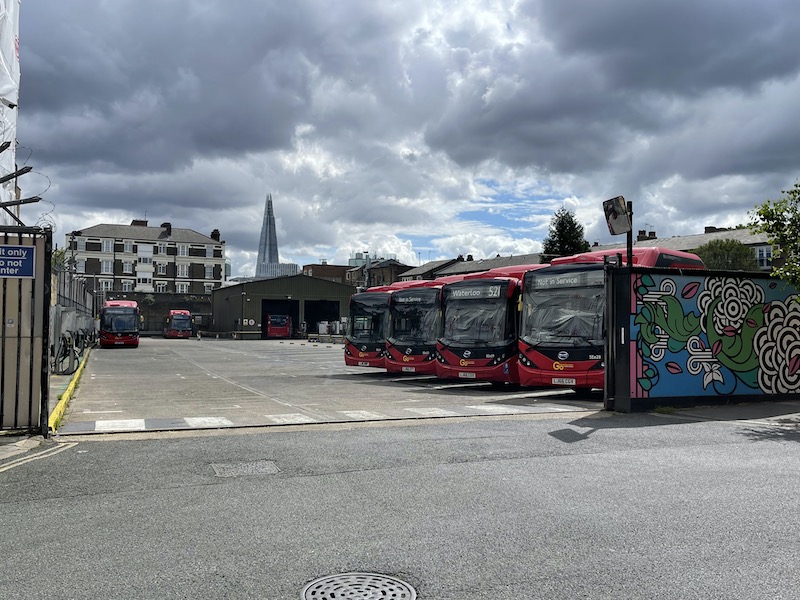
If route 521 goes what will happen to the excess capacity created at Go-Ahead London’s bus garage at Waterloo which had £20 million invested in recent times to become the first all electric bus garage in the country?
Especially if the plans for extending one of its other routes, the erstwhile Red Arrow branded route 507, to Fulham Broadway to partly replace the withdrawn route 11 proceed.

And, moving on to that proposal ….

….it won’t work unless something is done about the vehicle allocation.

Operating 21 seat single decks with a large area for standing passengers (as currently operated ‘Red Arrow style’) on the proposed route through Chelsea and Fulham will take us back to the hated ‘cattle truck’ descriptor of the ‘Merlin’ buses London Transport famously used on suburban routes in the late 1960s to howls of protest forcing retro fitting of extra seats.

These buses may be suited to commuters making short hop trips from Victoria, London Bridge and Waterloo to their offices but not longer journeys through the inner central suburbs. It will need double decks not standee single decks and frankly you might as well renumber the newly extended 507 to be route 11 and be acclaimed for “saving the famous route 11”.

But route 11 is currently operated with diesel hybrid powered New Routemasters whereas route 507 has electric powered single decks so it will look a rather retrograde step to convert back from electric to diesel and leaves the conundrum of how to utilise all the electric charging capacity at Waterloo bus garage – perhaps it’s future will be as yet another block of expensive flats and recoup that £20 million wasted investment.

I recently blogged about my snail’s pace journey on route 11 and observed route 26 (green) provides a like for like replacement east of Aldwych as the routes run in tandem from Liverpool Street. Now it’s proposed to extend route 26 to Victoria instead of Waterloo west of Aldwych it does makes sense to withdraw the poorly used snail like route 11.
I checked out route 26 crossing Waterloo Bridge and few will miss that section of route which is blessed with many alternatives. TfL reckon only 5% of passengers will face a change. I can believe it.

The 26 and 507 (to be numbered 11 and run with double decks) proposals make sense as a replacement for the current route 11 especially with the 507 diverting via Westminster Bridge rather than Lambeth Bridge thereby paralleling more of the current 11 west of Westminster.

Route 3’s (dark blue) diversion to Victoria instead of Whitehall to replace the diverted route 507 (purple) also makes sense with the Whitehall end of the route poorly used and was always a poor traffic objective once the route was progressively cut back from Oxford Circus.
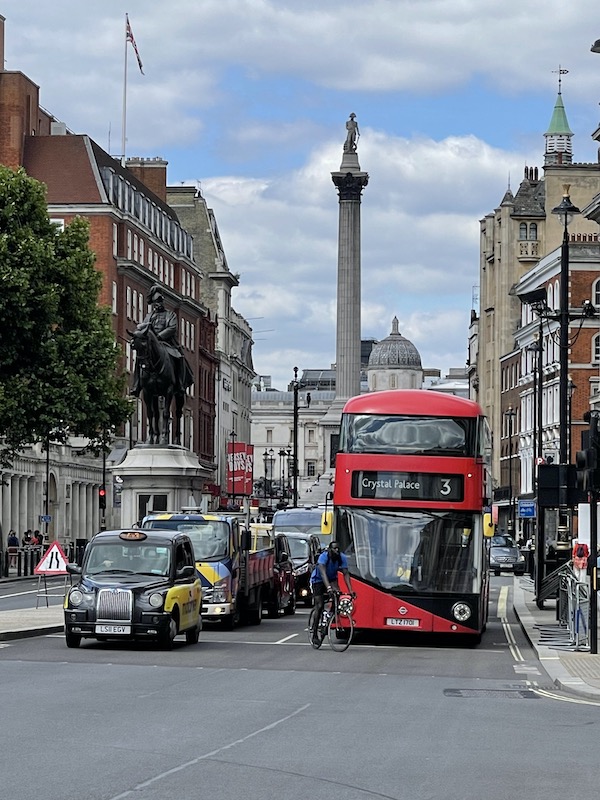
Route 507’s diversion over Westminster Bridge and extension into Chelsea also sees route 211 (orange in the ‘Fleet Street’ map further above) diverted from its eastern trajectory of Waterloo to instead run to Battersea Power Station (after Chelsea).

This seems to be a complete waste of a destination by weakening the eastern end of the route and what’s more TfL reckon 10% of passengers on route 211 will be impacted by the broken link to Waterloo. TfL state there’s “surplus capacity between Parliament Square and Chelsea Bridge Road” (so why send route 3 to Victoria?) and sending route 211 to Battersea Power Station “would provide a new link between Battersea Power Station and King’s Road which has been previously requested by the developers of the Vauxhall Nine Elms and Battersea Masterplan area”.

I’m just a bit sceptical whether the new residents of the developers’ luxury flats will be rushing down to the bus stop to catch a 211. It’ll be nice if they do, but in this era of serious financial challenge I’d have thought it better to terminate route 211 at Sloane Square if cost savings are the priority.
One other minor change highlighted on the Horseferry Road map above is route 77 changing its terminal point at Waterloo Station so it’s closer to the station building itself, which makes some sense.
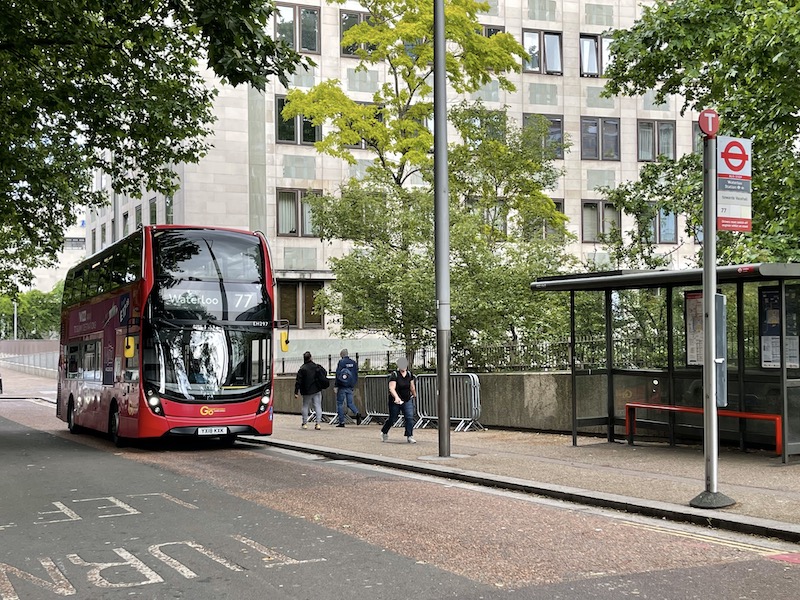
Another change in this part of London is the proposed withdrawal of route C3 between Clapham Junction and Earls Court.

I took a ride on this with some friends on Friday lunch time last week. Aside from ourselves we never got into double figures on the journey. It doesn’t take long to make an end-to-end journey – just 33 minutes. It takes nine buses to provide the 10 minute frequency. Yet arriving at the Earl’s Court Tesco terminus were four buses on layover – and with our arrival, a fifth, just as the front one was preparing to leave.

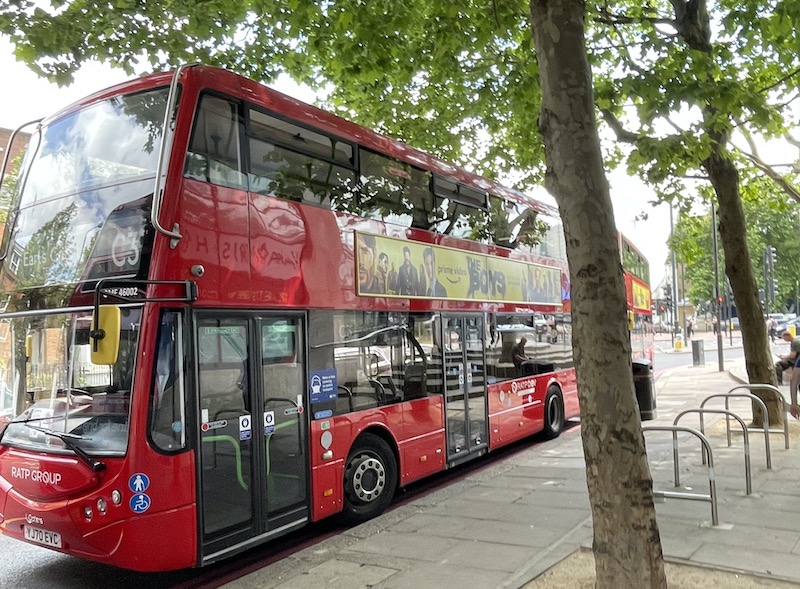
The flotilla was so long I couldn’t capture it in one photograph before the fifth one set off, but it amply illustrates one key reason why TfL’s finances are so dire – there’s far too much slack in the schedules. One tweeter made an observation that a couple of buses may have been on extended layovers due to a shortage of drivers. Even so, it’s not a good look.
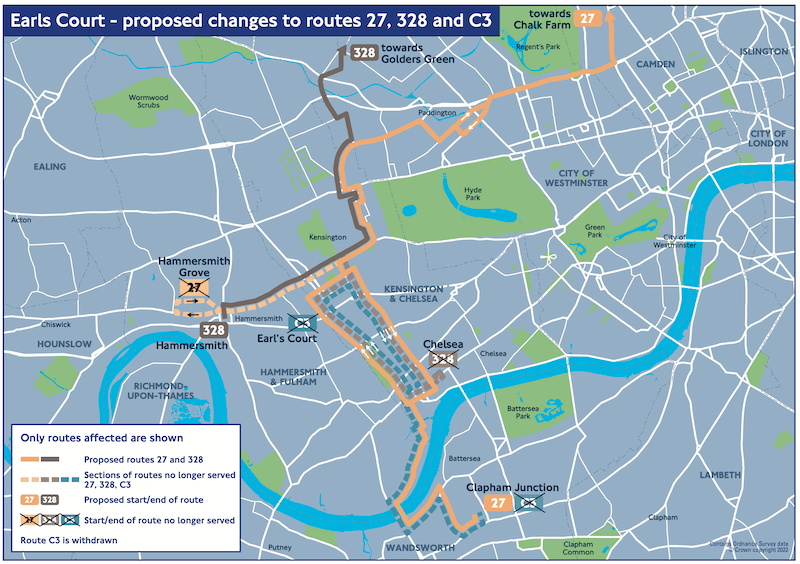
As the map above shows route C3 (light green-grey) will be replaced by a diversion of route 27 (light orange) away from its existing route to Hammersmith to take over the C3 instead, as well as route 328 (grey) being diverted away from Earls Court and Chelsea Worlds End to Hammersmith instead.

This makes no sense. Why disrupt route 27 at all? Just extend route 328 through to Clapham Junction to replace route C3 and leave route 27 well alone.

Another route for the chop is the long standing route 12 between Oxford Circus and Dulwich.

This will be replaced from Westminster like for like with an extension of route 148 from its existing Camberwell Green terminus on to Dulwich.

Ironically years ago, route 12 used to find its way out at Shepherds Bush where route 148 will now terminate (a slight modification from its recent extension to White City) but was cut back as part of the trend in those days to cut long distance cross-central London routes.

The most worrying thing about this proposal is the number of passengers who’ll be inconvenienced by having to change buses due to route 12 operating on the long established route via Piccadilly Circus and Trafalgar Square while route 148 operates via Hyde Park Corner and Victoria. It’s over a third. TfL reckon 6,830 daily trips on route 12, that’s 36%, will be impacted. That’s quite extraordinary and must demand a rethink. Perhaps it’s route 148 which needs culling and route 12 extended back to Shepherds Bush?

Further in south London is the demise of route 78 (pink) between Shoreditch and Nunhead near Peckham. It’s another route where over a third (4,697 – 36%) of passengers will need to change buses every day to complete their journey.

This is being replaced by an extension of route 388 (puce) from its existing London Bridge terminus.

The 388 is another route that’s been the subject of too many changes over the last few years with its southern terminus changing from Blackfriars to Elephant & Castle to Liverpool Street and to the current London Bridge. Hopefully its new foray to Peckham to replace the 78 will be the last change for a while.
Passengers don’t like constant change.

Unusually for TfL there’ll be a couple of bus stops used by route 78 unserved at its current terminus in Nunhead, but route P12 (not shown on the map) stops very close by as do other bus routes in Queens Road.
The map also shows a few other tweaks across London Bridge (as well as Tower Bridge losing its route 78). Route 47 (dark green) will be cut back from Shoreditch to head south from London Bridge south of the river while route 43 (yellow) will be cut back to Liverpool Street from north of the river. A handy reduction in a few buses will result on both routes with minimal impact on passengers – especially as route 141 duplicates the 43 south of Old Street.
Another proposal for similar reasons is route 343 (cream) cut back to Tower Gateway instead of Aldgate, where it only got extended in June 2019.

These curtailments make sense when you see the numbers travelling but the issue I have is the more you cut back routes from their ultimate destination, the fewer passengers are likely to travel, and in turn there could be further justifications for cuts in due course. Many bus routes thin out as they approach a terminus. You can’t keep cutting them back as a consequence, otherwise they disappear completely.
Finally for this Part 1, route 53 will be cut back from its Lambeth North terminus to nearby Elephant & Castle, Lambeth Road which I doubt many passengers will notice, nor a small change to route 171 in the Elephant & Castle area.

More on the other changes proposed by TfL in Part 2 in tomorrow’s blog.
Roger French
Blogging timetable: 06:00 TThSSu


Cannot disagree with one single word of that. Yes, reductions are necessary as loadings are extremely poor in places, but not by a wholesale “reshaping” of route patterns. As suggested, enormous savings could be made by merely slimming down routes and EFFICIENT scheduling, something TfL know little about. One of the disadvantages of franchising, soon to be “enjoyed” in some of our other great cities, is the inability to quickly change and/or rectify mistakes. Thus, some of the appalling route disturbances proposed here, will be with Londoners for years.
LikeLiked by 1 person
Running a major city bus operation on nostalgia and antiquated route networks wastes huge amounts of money, confuses users, duplicates routes and, needless to say, requires huge subsidies (now £4 Billion a year to TfL). It really is time that the entire network was revised to create major improvements in operation and efficiency. Currently it is a confusing, money wasting mess.
LikeLiked by 1 person
It seems there is no mention of boroughs like Bromley, which has been cut off from central London since the withdrawal of the No.1 back in the late 80’s. Now the No.47 is being cut back to London Bridge, cutting passengers off from Liverpool Street. After cut back to the No.53 is planned for 2023, terminating at the Elephant & Castle. South East London will see a massive increase in vehicular travel as they have little or no other means of travel.
LikeLiked by 1 person
Many of the public transport links in London date from the 1930’s, but the city has changed enormously since that time, both in size and passenger needs. It is pointless dealing with individual routes when the entire operation needs major revision to cut out duplication, waste and redundant sections and to produce an efficient, properly integrated network. TfL needs to wake up to the 21st century.
LikeLiked by 1 person
The 47 being cut short is frustrating, it’s the only bus from Canada Water to the City and Liverpool St. Yes you will be able to change at London Bridge but I doubt it will be at close bus stops and it’s always been a good route to have direct with heavy luggage and for wheelchair users. I can see the logic of some of the routes but where there is only one bus serving a particular route it is frustrating. Are there going to be any routes stopping on Tower Bridge now with the changes? I miss the RV1, that route was stopped against loud local protest because of ‘low usage numbers’ but consultation happened during covid so not a true representation, it was always busy in the evenings. As noted, some direct routes could be reduced rather than curtailed or removed altogether.
LikeLike
TfL’s bus network is complex and travel patterns vary by time and day of the week so it is difficult to judge based on just a handful of trips. The full impact of the opening of the Elizabeth line may not be being seen yet neither
What is clear is there is excess capacity in Central London.. Hopefully TfL has a lot of data for each route on passenger journeys. They should no where people get on the data on where they get off is probably less accurate. I guess they can base that on the reverse journeys but that’s tricky. If they are commuters they will travel in at about am and depart about 5pm. For shoppers and tourists it more difficult
Operating routes in sections can be one to better natch supply to passenger demand
Quite why TfL insist on so much stand time baffles me when almost all TfL routes are classed as high frequency and all they need to do it to maintain the headway. It should save TfL a lot of money unless I am missing something
Probably the city and West End are nowhere near as busy as they used to be. With the city its a mixture of WFH and the financial centre moving to Canary Wharf
With the West End the Elizabeth line will impact bus traffic
TfL’ discussions with the government are not going well as TfL are failing to meet the cost cutting targets they were set. TfL has already had over twice the funding the rest of England has. TfL about £3B and the rest of England about £1.4B
Given the dire state of bus services in the rest of England and their levelling up strategy cannot see them giving TfL much more funding
Another issue on the horizon is a Bus Strike over the cuts. TfL have stated their will be no redundancies and I would suspect that would be correct give staff shortages and staff turn over and they would probably offer early retirement and voluntary redundancy if need be
LikeLiked by 1 person
Agree with a lot of your analysis Roger but you’re underestimating the impact of the 521 at the Waterloo end especially. If you’d travelled at the peak you’d still see, even now, huge queues for the 521 at Waterloo and the buses arriving there from the south are already very busy. Otherwise you are bang on – so many changes are for designed so TFL can reduce mileage without thinking about where passengers actually go
LikeLike
I’m a non-Londoner these days and so my interest in TfL buses is primarily as an enthusiast. The exception is route 113 which I use into London on ENCTS-funded trips.
There’s a long common routing with the 13 between Fortune Green and Portman Square, but of course as this is London the timetables are not co-ordinated and so long gaps in service are commonplace. And the 113 is over-crowded at least during the evening rush hour between Swiss Cottage and Fiveways Corner.
I’ve taken the proposed withdrawal of the 31 as read. But I don’t like the diversion of the 113 to White City for the selfish reason that it takes out my direct access to central London. I’ve sent TfL a suggestion to divert the 13 instead (for the excellent reason that this would take it past the operating garage at Westbourne Park, and cut out the current crew changeover at Alpha Close where 13s are often abandoned at the side of the road). The 113 could then be sensibly extended to Victoria to preserve that destination for journeys from as far out as Fortune Green,
Roger, I think there’s a typo just above the first photo of Waterloo garage, where 113 fhould be 133.
LikeLiked by 1 person
Looking forward to your take on the Go North East cuts and possible solutions in a future blog….
LikeLiked by 1 person
If I lived closer I would.
LikeLike
If only route planners would understand that passengers dislike changing buses !
The inconvenience and uncertainty just put people off travelling
LikeLiked by 1 person
Breaking that down a bit, there are various elements to ‘dislike changing buses’: (1) the inconvenience, (2) the time wasted, and (3) the added uncertainty. IF (and it’s a big ‘if’) TfL were to seriously tackle all of these, there might be a much bigger benefit all round to travel in London, massively increasing the number of journeys by public transport
(1) – Big, Underground-quality way-finding signs at bus, bus-rail and bus/tube interchanges. Put bus stops right outside tube stations (hang the motorist). Tram-stop style shelters with seats. Public toilets within easy reach. Convenient road-crossings with any accessibility requirements provided.
(2) – Really frequent buses on all routes; making people change bus when they may have to wait 12-15 minutes is stupid. More bus-priority…
(3) – Real-time passenger-info at ALL stops.
LikeLiked by 1 person
Good post. I wonder why it took so long to produce the explanatory maps. They’re not in a rush to introduce these changes, so why hurry the consultation?
I’ve had enough time to know what’s going on now, but one thing I hadn’t noticed until the new maps come out is that the 133 is shown as going via Bank instead of Cannon Street. Thus, all it does to replace the 521 is linking London Bridge with St Paul’s, and even that’s adequately served by route 17 from the other side of the cathedral. Why not retain it at Liverpool Street Station?
Roger, what’s your opinion on the longer lengths of these routes? Like the 388, 1, 148, 113 and 27. Wasn’t long ago TFL were splitting and chopping all the long routes in the name of reliability, now we’re moving back to them.
LikeLiked by 1 person
Good point re 133 routing … and agree there seems to be a new policy of lengthening routes again.
LikeLike
As stated in the article, many London bus routes date from the 1930’s and are no longer relevant to passenger requirements and the way that London has developed in the past 90 years. There is a great deal of duplication and redundancy in the overall network and, hence, major revision is necessary. TfL financial losses are now huge because of this and ultra low fares, running into Billions of pounds, and a complete overhaul of TfL’s operation is absolutely vital.
LikeLiked by 1 person
Yes many of the routes are based on old tram routes
Today we have new underground lines. Fleet Street is no longer so importent. The City Financial Centre has moved from the City to Canary Wharf. The West End is no long as bigger draw as it used to be. Many more people working from home. In outer London Brent Cross is no Longer the big draw it once was and the ULZ and LEZ etc discourages people from comming into London
LikeLiked by 1 person
A colleague, living in Hampshire, is adverse to travelling on the Underground. So, he routinely travels from Waterloo to Euston on the 59 bus.
It looks as though this will no longer be possible. For him, it will be of no use to be told that the Tube is an available alternative. Now, I would not profess that his loss is going to be significant, but I wonder how TfL square this with their policies on equality, diversity and the needs of minorities.
LikeLike
Route 68 (and the restructured route 1) will still continue to operate between Waterloo and Euston.
LikeLike
I don’t think TfL will base their decisions on the eccentricity of someone living in Hampshire. I want to travel by trolleybus, s when are they going to wire up my local route?
LikeLiked by 1 person
It’t not really an eccentricity though. I’ve used the bus from Waterloo to Euston more often then doing it by tube and I know several people who do the same. This sort of journey is a good example of one that’s often preferred by people with luggage or who are mobility impaired as it’s much easier than the tube.
I’m also not convinced that routes are wrong just because they have been around since the 1930s. In fact it’s often the opposite – they follow major flows which is why they have endured for so long. The network may be long overdue an overhaul but needlessly breaking long established links seems a strange way to go about it.
LikeLiked by 1 person
The 521 from Waterloo eastbound runs through the old tram tunnel and avoids the congestion on the now-narrowed Waterloo Bridge, and skips two stops and two major sets of lights. The proposed replacement will crawl through this lot, so it will be much slower even where no change of bus is needed.
LikeLiked by 1 person
the proposal for Route 12 is a step too far, I agree with Roger that it is perhaps the cull should go to the 148 not the 12 and simply extend it back to Shepherds Bush as has been suggested, but I suspect that TfL probally don’t want it to return to its original routeing via Picadilly and Oxford Street as they may still want to reduce congestion along Oxford St so I suppose it could still follow the existing 148 routeing via Victoria but I honestly think it should return to its original route.
LikeLiked by 1 person
With these cuts and TfL cutting the PVR of most routes when they come up for renewal there will have to be garage closures
LikeLiked by 1 person
Is there any allocation of route numbers to different types of route? Those crossing the River, or entering central London? Certainly, if I found my classic single or double digit route replaced by a random triple numbered one it would not inspire confidence for its future.
LikeLiked by 1 person
Used to be a scheme of sorts. London Red buses used 1 to 299. London country Bus North 300 to 399. London Country South of River 400 to 499. Greenline 700 to 799
Trollybus 500 to 699. Why they used two blocks of numbers I dont know as they did not need two blocks.
Nowadays with route numbering anything goes
There was intially some logic to the Routes being with a letter but that went out of the window
Routes begining W orginally indicated Wood Green but later on theu used W for routes in Walthamstow
LikeLike
Trolleybus bus routes were numbered in the 500 series to the north of the River Thames and 600s south of the river. Inevitability there were a few exceptions to the rule where routes crossed the Thames, generally to terminate somewhere sensible.
LikeLike
Trolleybus routes were not numbered by the logic as “Pera409 suggests. The 517/617 and 521/621 routes all started from North Finchley to Holborn Circus, the 517/617 on the direct route and 521/621 via Wood Green, but they all all terminated at Holborn, the difference between 517/617 and 521/621 was that they operated in opposite directions round the loop before Holborn, rather like the trams 16/18 along the circular Embankment route.
And if the author of the main blog is so knowledgeable and keen, I trust he has forwarded his views, comments and suggestions to TfL rather than just sounding off to the world at large?
LikeLike
Barnes Bus Changes
Route 209 will be reduced in frequency from four to two buses an hour
Route 378 will be rerouted via Barnes Pond, continuing on to Church Road from Barnes High Street before turning right onto Rocks Lane and then left into Mill Hill Road. This means it will no longer serve Station Road and the West of Mill Hill Road. Route 378 will also be reduced in frequency from eight to four buses an hour
Route 533 buses will resume serving all stops between Chiswick and Mortlake Cemetery in both directions. Buses will run every 17 minutes, instead of every 15 minutes, during morning and evening periods
LikeLike
As for the 45 changes, that’s often left out because it’s forced to withdraw from King’s Cross and Elephant & Castle back in June 2019 as 40 took over Clerkenwell Green the quality of service in London we have reduced our hopper fare. From my recollection of the 45 extensions, We need to consider the benefits that passengers whose is limited to SW would be that attracted to travel Wandswoth borough via Magdalen Road to terminate at Earlsfield or Garratt Lane Wimbledon Rd (bus stand). 35 amend the 45 from Elephant to Brixton then Has 8 stops between Clapham Park. 40 amend the 176 from Southwark to Dulwich. Fenchurch Street has left unserved.
https://unormlondonbusblog.blogspot.com/2022/04/routes-322-and-432-2015-2022.html?m=1
https://www.brixtonbuzz.com/2022/06/45-bus-route-through-brixton-likely-to-be-withdrawn-under-transport-for-london-tfl-plans/
http://londonbusesonthego.blogspot.com/2018/08/the-demise-of-central-london.html?m=1
LikeLike
As for the 45 changes, that’s often left out because it’s forced to withdraw from King’s Cross and Elephant & Castle back in June 2019 as 40 took over Clerkenwell Green the quality of service in London we have reduced our hopper fare. From my recollection of the 45 extensions, We need to consider the benefits that passengers whose is limited to SW would be that attracted to travel Merton borough via 155/219 to terminate at Colliers Wood (Bus Stand) or Mitcham via 355. 35 amend the 45 from Elephant to Brixton then Has 8 stops between Clapham Park. 40 amend the 176 from Southwark to Dulwich. Fenchurch Street has left unserved.
https://unormlondonbusblog.blogspot.com/2022/04/routes-322-and-432-2015-2022.html?m=1
https://www.brixtonbuzz.com/2022/06/45-bus-route-through-brixton-likely-to-be-withdrawn-under-transport-for-london-tfl-plans/
http://londonbusesonthego.blogspot.com/2018/08/the-demise-of-central-london.html?m=1
https://www.google.com/maps/@51.4165763,-0.1786682,3a,30y,250.57h,88.05t/data=!3m6!1e1!3m4!1sPEwAPBFONTiCTCkC6H94pw!2e0!7i16384!8i8192
LikeLike